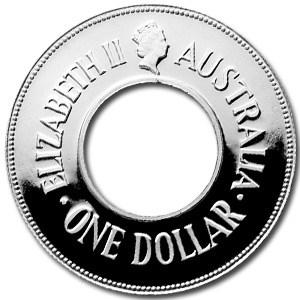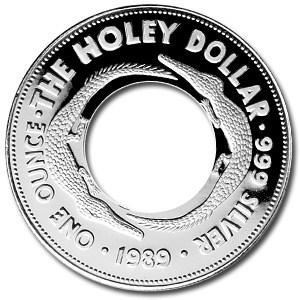The Australian one ounce silver piece (abbreviated as 1 oz and designated with Ag for "silver") is a bullion and commemorative coin format. Uniquely, in Australia there are two mints authorised to strike legal tender: the Royal Australian Mint (which also makes the country's circulating coinage) and the Perth Mint which only makes collector and bullion coins, as well as other bullion products.
Both mints endeavour to create coins with attractive designs, and to introduce new designs and themes often, in order to raise the numismatic value of the coins over the value of previous metal used.
This coin is part of the second "Holey Dollar" and "Dump" set issued by the Perth Mint.
The set contains two coins: a large (one ounce) coin with the shape of a ring, and a small "dump" which fits within the whole of the large coin. They are styled after the Holey Dollar and the dump, which were a form of emergency money in the colony of New South Wales. In 1813, in order to overcome a shortage of circulating coinage, the colonial government authorised the cutting out of a small piece (the dump) from a quantity of Spanish 8 Reales coins ("Spanish dollar), with the resulting two pieces being over-stamped as five shillings on the ring, and fifteen pence on the dump.
The 1989 set portrays freshwater crocodiles and the Wandjina. Alternatively written as Wanjina and Wondjina, and also known as Gulingi, the Wandjina are cloud and rain spirits from Australian Aboriginal mythology that are depicted prominently in rock art in Australia. Some of the artwork in the Kimberley region of Western Australia dates back to approximately 4,000 years ago. | 




 Search for Australia: Silver Ounce 1989 Holey Dollar - Freshwater Crocodiles on eBay
Search for Australia: Silver Ounce 1989 Holey Dollar - Freshwater Crocodiles on eBay 
